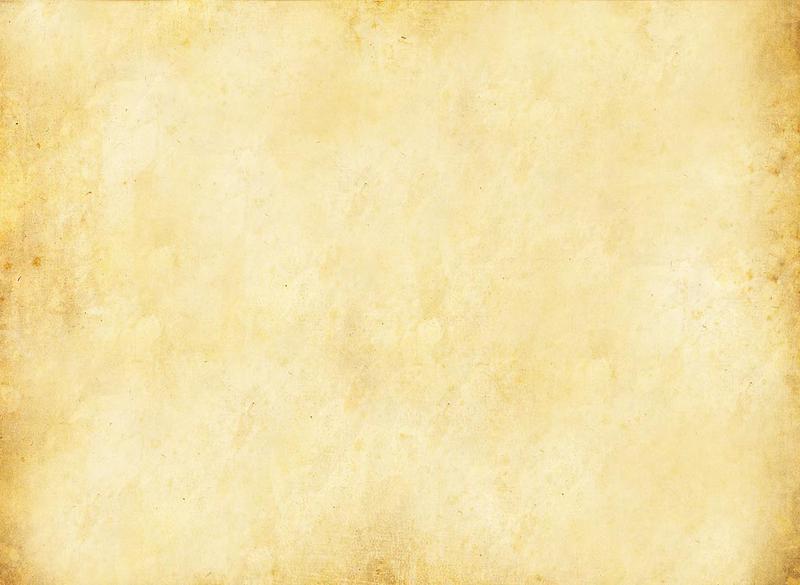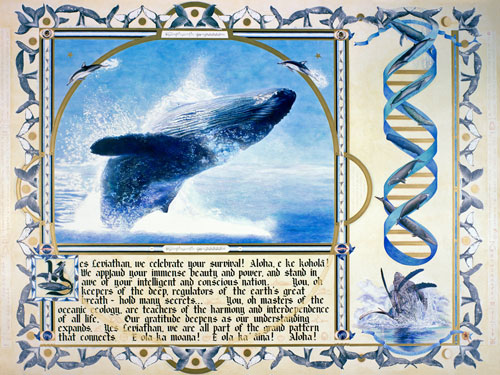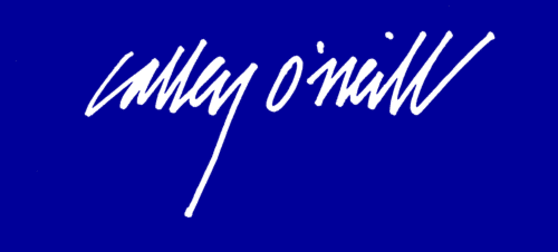Aloha, e ke Kohola! is, at once, a memorial to commemorate the millions of great whales who have perished, and a celebration for those who have indeed shown hopeful signs of flourishing and making a comeback. The mural was dedicated to the late, great author and seaman, Tommy Holmes, who Calley loved to call ‘Swami Maritime’. Tommy Holmes cared very deeply and worked intensely for the health and well being of the land, the Native Hawaiians, the sea and all its diverse families of inhabitants.
 Happily, the mural in progress was a revelation for the artist, quite magically revealing itself to her, and thus to you. The artist dove into the project as if into a pool, only to find she was seeking to understand a realm as deep and mysterious as life itself.
Happily, the mural in progress was a revelation for the artist, quite magically revealing itself to her, and thus to you. The artist dove into the project as if into a pool, only to find she was seeking to understand a realm as deep and mysterious as life itself.
 Days of painting and evenings of reading about the great whales spun into nights of dreaming with the creatures in all their majesty. Wonderful, impossible questions arose out of the depths as to the nature the nature of these entities, and the nature of intelligence, the senses, communication and consciousness.
Days of painting and evenings of reading about the great whales spun into nights of dreaming with the creatures in all their majesty. Wonderful, impossible questions arose out of the depths as to the nature the nature of these entities, and the nature of intelligence, the senses, communication and consciousness.
 During the time that this mural was being painted, Congress reauthorized the 1972 Marine Mammal Protection Act; and the world watched as the Superpowers, under the timeless guidance of Native Alaskans, guided two Gray Whales trapped in the Arctic Ice out into open waters. This marked a turning point for humanity, an awareness of our responsibility for protecting rather than exploiting the whale nations.
During the time that this mural was being painted, Congress reauthorized the 1972 Marine Mammal Protection Act; and the world watched as the Superpowers, under the timeless guidance of Native Alaskans, guided two Gray Whales trapped in the Arctic Ice out into open waters. This marked a turning point for humanity, an awareness of our responsibility for protecting rather than exploiting the whale nations.
 As canaries were sensors for the miners as to the quality of air in the mines, whales are to us sensors of the balance of life in the oceans. So it is that this mural celebration is dedicated to these remarkable cetacean survivors and all of their rescuers. May all whales great and small, be allowed to fulfill their essential destinies ~ to grow old, very old, while tending their oceanic farms of plankton -- perfectly harvesting them.
As canaries were sensors for the miners as to the quality of air in the mines, whales are to us sensors of the balance of life in the oceans. So it is that this mural celebration is dedicated to these remarkable cetacean survivors and all of their rescuers. May all whales great and small, be allowed to fulfill their essential destinies ~ to grow old, very old, while tending their oceanic farms of plankton -- perfectly harvesting them.
Preserving the ocean. Creating the breath of PAPA, the Mother Earth. Our breath. Perfectly Being… Being born in warm Hawaiian waters. E Komo Mai! Aloha i Hawai'i!
 After an eleven-month pregnancy, it takes just 20 minutes to 2 hours for an infant humpback, 1/3 the size of mom, to be born in the dense, warm supportive waters here.
After an eleven-month pregnancy, it takes just 20 minutes to 2 hours for an infant humpback, 1/3 the size of mom, to be born in the dense, warm supportive waters here.
 If he be a male, he will soon learn to sing the ever evolving, long and complex tone poems, which, when sung within the ocean's special reflecting layers, literally ring out around the entire globe. The songs vary widely in pitch and character and last between six and thirty minutes, with solos, duets, trios and even large choruses singing the same compositions, which change year after year. Although to our knowledge they have never met, amazingly, the whales in Mexico wind up singing the exact same song as the male whales in the Hawaiian waters, thousands of miles apart.
If he be a male, he will soon learn to sing the ever evolving, long and complex tone poems, which, when sung within the ocean's special reflecting layers, literally ring out around the entire globe. The songs vary widely in pitch and character and last between six and thirty minutes, with solos, duets, trios and even large choruses singing the same compositions, which change year after year. Although to our knowledge they have never met, amazingly, the whales in Mexico wind up singing the exact same song as the male whales in the Hawaiian waters, thousands of miles apart.
 May they sing and play for all the world's children to enjoy! Much of the humpbacks’ whale play is immensely acrobatic and entertaining. In a full breach, the entire 40-ton whale comes out of the water, resulting in a thunderous slap that can be heard and seen for miles.
May they sing and play for all the world's children to enjoy! Much of the humpbacks’ whale play is immensely acrobatic and entertaining. In a full breach, the entire 40-ton whale comes out of the water, resulting in a thunderous slap that can be heard and seen for miles.
 During their annual migration, moms and infants are usually the last to begin the 5,000-mile nonstop ‘flight’ through the diverse and mountainous seascape winter home in Hawai’I to the cold, fertile richness of the polar seas. Hawaiian waters are a desert in comparison to the rich northern waters, where all the major feeding takes place during the Alaskan summer. It is thought that whales fast, breed and give birth in their tropical winter home of Hawai’i.
During their annual migration, moms and infants are usually the last to begin the 5,000-mile nonstop ‘flight’ through the diverse and mountainous seascape winter home in Hawai’I to the cold, fertile richness of the polar seas. Hawaiian waters are a desert in comparison to the rich northern waters, where all the major feeding takes place during the Alaskan summer. It is thought that whales fast, breed and give birth in their tropical winter home of Hawai’i.
 In a very short food chain, it takes 100 pounds of plankton to make 10 pounds of krill and small fishes like herring to make one pound of leviathan. A humpback’s stomach can hold 1,200 pounds of food, and it takes a huge number of 2” long krill to fill it. Note the bubble net on the upper right of the DNA strand in the mural. From a great depth, one or several humpbacks swim upward in a large, graceful spiral, blowing bubbles up to 5’ in diameter. The shrimp like krill concentrate in a column in the center of the cylindrical bubble net which the humpback, with giant, accordion mouth open wide (a mouth which could hold 14 humans) swims through to harvest the catch!
In a very short food chain, it takes 100 pounds of plankton to make 10 pounds of krill and small fishes like herring to make one pound of leviathan. A humpback’s stomach can hold 1,200 pounds of food, and it takes a huge number of 2” long krill to fill it. Note the bubble net on the upper right of the DNA strand in the mural. From a great depth, one or several humpbacks swim upward in a large, graceful spiral, blowing bubbles up to 5’ in diameter. The shrimp like krill concentrate in a column in the center of the cylindrical bubble net which the humpback, with giant, accordion mouth open wide (a mouth which could hold 14 humans) swims through to harvest the catch!
 Not quite believing this bubble net strategy, one scientist set out to net the speedy, hissing little crustaceans. Thirty determined swooshes of his net yielded just a mere three specimens, yet one full swoop inside the circle of a bubble net yielded a full catch. In a similar method, fin whales reflect light from their white underbellies to concentrate small fishes in a circular light net!
Not quite believing this bubble net strategy, one scientist set out to net the speedy, hissing little crustaceans. Thirty determined swooshes of his net yielded just a mere three specimens, yet one full swoop inside the circle of a bubble net yielded a full catch. In a similar method, fin whales reflect light from their white underbellies to concentrate small fishes in a circular light net!
 Whales are amazing creatures, with large, complex brains. They are rare…and endangered. The eight species painted into the double helix are endangered, and have been protected from commercial whaling for nearly two decades, thus the happy comeback of populations such as the gray whale and the humpbacks. Unfortunately, the right whales, bowheads, and blue whales, reduced to a tiny fraction of their original populations, are isolated around the globe and are in danger of extinction.
Whales are amazing creatures, with large, complex brains. They are rare…and endangered. The eight species painted into the double helix are endangered, and have been protected from commercial whaling for nearly two decades, thus the happy comeback of populations such as the gray whale and the humpbacks. Unfortunately, the right whales, bowheads, and blue whales, reduced to a tiny fraction of their original populations, are isolated around the globe and are in danger of extinction.
 Seriously endangered, the awesome blue whales, largest living creatures to have ever inhabited Earth, may have been considerably larger in times gone by. Imagine having 8 tons of blood pumped by a heart weighing half a ton through arteries big enough for us to swim through! Imagine the blue whales’ 188 decibel whistle, louder than the Concorde supersonic transport! Imagine a streamlined 100’ long, 150 ton muscular female giving birth to a 3 ton, 25-foot long infant, who gains up to 200 pounds a day while nursing! And statements such as this merely hint at the colossal physical reality of the mighty blues…with tails wider than the mural painting (12’ high x 17’ wide)
Seriously endangered, the awesome blue whales, largest living creatures to have ever inhabited Earth, may have been considerably larger in times gone by. Imagine having 8 tons of blood pumped by a heart weighing half a ton through arteries big enough for us to swim through! Imagine the blue whales’ 188 decibel whistle, louder than the Concorde supersonic transport! Imagine a streamlined 100’ long, 150 ton muscular female giving birth to a 3 ton, 25-foot long infant, who gains up to 200 pounds a day while nursing! And statements such as this merely hint at the colossal physical reality of the mighty blues…with tails wider than the mural painting (12’ high x 17’ wide)
 Through photo identification of the distinctive whale’s tails (with scars like hieroglyphs amidst their distinguishing color patterns) individual whales and groups can be studied without so much as the death of a single individual. A quantum leap for ecology, as only the study of life alive will assist us in solving the great mystery. Whales are amazing creatures. One need only be open to the mystery to be captivated by whales, great and small.
Through photo identification of the distinctive whale’s tails (with scars like hieroglyphs amidst their distinguishing color patterns) individual whales and groups can be studied without so much as the death of a single individual. A quantum leap for ecology, as only the study of life alive will assist us in solving the great mystery. Whales are amazing creatures. One need only be open to the mystery to be captivated by whales, great and small.
E ola ka’aina! So that the land may live!
E ola ka moana! So that the oceans may live!
Aloha!
 ACKNOWLEDGEMENTS: The artist offers heartfelt gratitude to the Hawaii Maritime Center Directors, Founder Tommy Holmes, and Dr. Everts C. Fox, for this extraordinary mural experience. Thanks to designer, Tom Coffman, coordinator Al deGagne, Jose Flores, Adan Eads and the entire museum design and building crews for their help and enthusiastic encouragement. Shiu Chin Hsu and Laura Wilburn assisted with the gold borders. The artist acknowledges a fellow Big Islander, research biologist Dan McSweeney for his dynamic reference photo of the breaching humpback, his review of the mural, and his continued cetacean studies. Mahalo nui loa to the translators for their thoughtful contributions, especially Rubellite Kawena Johnson. The mural is painted in Politec, paint of the Mexican mural masters, and was photographed by Jeff Helbert. Harbor Graphics and Fine Printing printed the poster in Hawaii on recycled paper. A portion of the proceeds from print sales will be donated to THE RAMA EXHIBITION. Thanks to Mat Simpson and Bob Goodman for Whalesong, a pictorial history of whaling in Hawaii, and especially to Heathcote Williams for his inspired epic poem, Whale Nation.
ACKNOWLEDGEMENTS: The artist offers heartfelt gratitude to the Hawaii Maritime Center Directors, Founder Tommy Holmes, and Dr. Everts C. Fox, for this extraordinary mural experience. Thanks to designer, Tom Coffman, coordinator Al deGagne, Jose Flores, Adan Eads and the entire museum design and building crews for their help and enthusiastic encouragement. Shiu Chin Hsu and Laura Wilburn assisted with the gold borders. The artist acknowledges a fellow Big Islander, research biologist Dan McSweeney for his dynamic reference photo of the breaching humpback, his review of the mural, and his continued cetacean studies. Mahalo nui loa to the translators for their thoughtful contributions, especially Rubellite Kawena Johnson. The mural is painted in Politec, paint of the Mexican mural masters, and was photographed by Jeff Helbert. Harbor Graphics and Fine Printing printed the poster in Hawaii on recycled paper. A portion of the proceeds from print sales will be donated to THE RAMA EXHIBITION. Thanks to Mat Simpson and Bob Goodman for Whalesong, a pictorial history of whaling in Hawaii, and especially to Heathcote Williams for his inspired epic poem, Whale Nation.
 My imagination is, as you might say, permanently sparked!
My imagination is, as you might say, permanently sparked!
Aloha, e ke Kohola! A Mural Celebrating the Survival of the Humpbacks, 1988 (12’ by 17') mixed media mural with Politec, paint of the Mexican mural masters, wood and metallic gold, Hawai’I Maritime Center, Pier Seven, Honolulu, Hawai’i.
Art and Soul for the Earth
Big Island of Hawai'i





